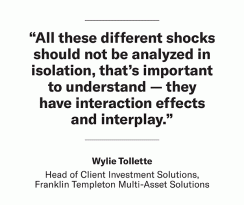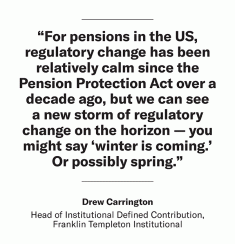The investment experts at Franklin Templeton spend a lot of time speaking to chief investment officers about “What if . . .” That is, the most beneficial discussions come from exploring the implications of what might happen—not guessing the future—and being prepared for those risks.
In the following conversation, two key players at Franklin Templeton Multi-Asset Solutions—Wylie Tollette, Head of Client Investment Solutions, and Gene Podkaminer, Head of Multi-Asset Research Strategies—and fellow expert Drew Carrington, Head of Institutional Defined Contribution, Franklin Templeton Institutional, examine the “what if” of regulations—why winter or spring may be on the horizon, and why it might be time to buy snow shoes or sunscreen.
Gene Podkaminer: Regulation often isn’t enacted for optimal investment reasons, but it’s regulation nonetheless and you have to follow it. Regulation literally defines the rules of the game. If I’m a corporate treasurer, one thing that’s certainly on my mind as I’ve repatriated assets and my coffers are now a bit better stocked than they were before, what do I do with this cash infusion? That’s a purely regulatory reaction. How do I invest this so that all my stakeholders are happy?
From a regulator perspective, there’s a huge difference between what drives public pension plans versus corporate pension plans.

Podkaminer: It’s a possible driver of inflation.
Tollette: Right, it might go back to inflation. All these different shocks should not be analyzed in isolation, that’s important to understand—they have interaction effects and interplay. Regulatory shocks, rate shocks, growth shocks: They’re all very tightly interrelated. If I were making investment decisions, I would advocate thinking about that portfolio much more holistically across all of these shocks in concert with one another and align with understanding my liabilities and my funding sources.
Podkaminer: The difference with a regulatory shock is that it changes the rules of the game. None of the other types of shocks do that.

Tollette: The Pension Protection Act, or PPA, came about following a variety of very high-profile corporate bankruptcies where the pension plans ended up falling short. Congress stepped in with the idea of helping to protect pensioners in the event of similar corporate bankruptcy. That came about through looking at the investments they could make, as well as the premiums they would pay for PBGC insurance, as well as what the insurance would cover. That was the intended effect. The unintended consequences of the Pension Protection Act were basically to have most corporations seek to eliminate pensions entirely.
Podkaminer: In all fairness, corporations had been moving slowly in that direction—but the acceleration caused by the PPA can’t be overstated. It also was one of the first pieces of regulation that enforced mark-to-market accounting in the pension space. That’s something that has been looked at by a lot of different academics and think tanks in both the corporate and the public spheres. It hasn’t stuck on the public side, but for corporates it certainly did; and again, it changed the rules of the game. Suddenly, you’re forced to look at your assets and liabilities together and the term of interest became the difference between those assets and liabilities–surplus. Once you do it that way, you start taking uncompensated risk off the table. In the surplus dimension, you want to reduce surplus risk, and so you have much more fixed income in your portfolio because it’s a better match for your liabilities. Incidentally, the regulatory focus on surplus is well established for pension plans across the Atlantic, and results in portfolios are constructed fundamentally differently than in the US.
Carrington: Certainly, one of the unintended consequences of the PPA was the significant reduction in pension coverage. I don’t think any of the framers of the PPA anticipated that outcome at all. I was at an event in 2016 with many of the legislative aides who were part of the passage of the PPA, and they expressed a lot of surprise and dismay over the outcome. It wasn’t what was intended, but it changed the way risk is communicated, translated, and recorded. The risks of pension plans were always there, and it wasn’t as if suddenly mortality risks changed, or interest risk changed, or equity risk changed. But it had to be reported in a different way, and a lot of corporate CFOs and CEOs didn’t want to talk about the pension plan on earnings calls anymore.
Tollette: Interestingly, similar trends occurred in the UK, where an evolving awareness of the full cost of a defined benefit plan—in terms of demographics, longevity risk, inflation risk, all the different costs that those employers now understand more fully, and the equity risk that has been necessary to achieve return expectations commensurate with the funding requirements—all of those things have influenced a fairly dramatic shift toward defined contribution plans.
Carrington: Right now, in the U.S.—really for the first time since the PPA was passed—there’s been a flurry of activity around the retirement space from a regulatory perspective. If they come to be, some of these changes could be particularly far-reaching. For example, the discussion of multi-employer plans (MEPs), while not mandating coverage contributions on the part of employers, do move us one step closer to an Australian-style system where the employer is not the central provider of the retirement plan. In fact, the MEP is an independent institution. It has many advantages, but there are aspects of it that I think will be challenging in the US, particularly the mandated contribution element. The word itself—mandate—just has no traction in Washington, D.C., right now. Anything requiring that plan sponsors behave in certain ways is unlikely to pass. Giving plan sponsors additional choices, additional coverage, is much more likely to move.
If we play with the concept, MEPs would create a third path in the retirement savings marketplace today.
Tollette: But to go back to where we started, who knows what the unintended consequences might be?
Carrington: Correct. Right now, we have DC plans and IRAs, and almost all the money in the IRA marketplace came from DC plan rollovers—something close to more than 90% in any given year. If we create this new thing, an open MEP, does it become a third player in the space? Neither fish nor fowl, right? It’s not employer-sponsored in the sense of the traditional 401(k), but it has the ability to do everything the 401(k) can do.
Podkaminer: MEPs might open the door to offering alternatives or liquid assets in retirement plans without employers being worried about getting sued for offering something that’s more expensive. You can’t easily get alternatives in an IRA, but you could in a MEP. That could open the door for improved diversification for plan participants.
Carrington: Perhaps employers might look to get entirely out of the plan sponsor business. My instinct is that wouldn’t happen, however. In the investment business, we tend to look at 401(k) plans as investment options. Employers use their plans across a wide array of functions, including as a competitive advantage to attract and retain talent. Employers view retirement planning as one piece of overall financial wellness that they can offer employees. It would be a big step for a sponsor to hand off the plan to an outside provider and still provide broad, holistic service delivery.
Tollette: To play off an earlier comment, change is coming in the US retirement system, and we need to make sure that we know whether we need snow shoes, skis, or sunscreen! Being alert to the weather forecast in Washington, D.C., can help employers and investors manage regulatory shocks and risks.
Wylie, Gene, and Drew are happy to speak to you about your “what if” scenarios. Feel free to contact them at solutions@franklintempleton.com:
Wylie Tollette, CFA, CPA
Head of Client Investment Solutions
Franklin Templeton Multi-Asset Solutions
Gene Podkaminer, CFA
Head of Multi-Asset Research Strategies
Franklin Templeton Multi-Asset Solutions
Drew Carrington, CFA, CAIA
Head of Institutional Defined Contribution
Franklin Templeton Institutional
More in the series "What if there are shocks to ... "

Franklin Templeton
| 
Franklin Templeton
| 
FT demographics
| 
Franklin Templeton
|

Franklin Templeton
| 
FT-global growth
| 
interest rates
| 
FT
|
Disclaimers
This material is provided for informational purposes only and nothing herein constitutes investment, legal, accounting or tax advice. This material is general in nature and is not directed to any category of investors and should not be regarded as individualized, a recommendation, investment advice or a suggestion to engage in or refrain from any investment-related course of action. All information is current as of the date of this material and is subject to change without notice. Any views or opinions expressed may not reflect those of the firm or the firm as a whole. Franklin Templeton does not accept any responsibility to update any opinions or other information contained in this document. This material may include estimates, outlooks, projections and other “forward-looking statements.” Due to a variety of factors, actual events may differ significantly from those presented.
CFA® and Chartered Financial Analyst® are trademarks owned by CFA Institute.
For US Residents Only
If you would like information on Franklin Templeton’s retail mutual funds, please visit www.franklintempleton.com.
Franklin Templeton Distributors, Inc.






